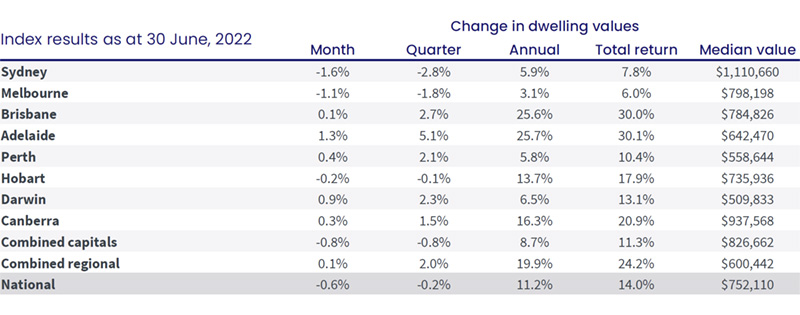Sydney, Melbourne lead national property prices lower
Australia's property prices have fallen for a second consecutive month, with Sydney and Melbourne in a downturn and the other mainland capitals growing but slowing.
Like an aircraft carrier trying to reverse from full speed ahead, the seemingly unstoppable and impregnable Australian property market has gone from all guns blazing to reversing into port.
After years of smooth sailing at a record rate of knots, national property prices have fallen for the second consecutive month.
Prices were down by 0.6 per cent to finish 0.2 per cent lower over the June quarter, according CoreLogic’s national Home Value Index (HVI).
Sydney (-1.6 per cent month and -2.8 per cent quarter) and Melbourne (-1.1 per cent month and -1.8 per cent quarter) are the cities in the armada taking the hits, while Adelaide, Perth and Brisbane continue to eek out a slow pace of growth.
Housing values were also down in Hobart (-0.2 per cent month and -0.1 per cent quarter) as well as regional Victoria (-0.1 per cent month and +1.2 per cent quarter).
Every capital city and broad rest of state region is now well past their peak rate of growth as trend rates eased across the remaining markets.
Brisbane has surrendered its position at the front of the fleet to Adelaide and Perth.
The Queensland capital has seen growth in real estate values flatten out to just 0.1 per cent in June, while Adelaide remains the only capital still recording a monthly growth rate higher than 1.0 per cent (1.3 per cent).
Growth in Perth’s housing values, which were temporarily showing a second wind as state borders reopened, are again losing steam with values up 0.4 per cent in June.
Source CoreLogic.
A fear of missing out is being replaced by trepidation to step in.
CoreLogic Research Director, Tim Lawless, noted the housing market’s sharper reduction in growth coincides with the May cash rate hike, surging inflation and low consumer sentiment.
“Housing value growth has been easing since moving through a peak in March last year, when early drivers of the slowdown included rising fixed term mortgage rates, an expiry of fiscal support, a trend towards lower consumer sentiment, affordability challenges and tighter credit conditions,” he said.
“More recently, surging inflation and a rapidly rising cash rate have added further momentum to the downwards trend.
“Considering inflation is likely to remain stubbornly high for some time, and interest rates are expected to rise substantially in response, it’s likely the rate of decline in housing values will continue to gather steam and become more widespread.”
Property Investment Professionals of Australia (PIPA) Chair Nicola McDougall said property markets remain sound with experienced homebuyers and investors understanding the central bank’s need to increase interest rates from their emergency pandemic-induced lows.
“While, yes, the rate rises are earlier than the central bank had indicated, I don’t think any of us really wanted to believe that the cash rate would need to stay at such an emergency low level for multiple years,” Ms McDougall said.
“That’s because, if it did, it would mean that our economy was in very bad shape indeed, which would be a bad thing for all of us – rather than the opposite.”
Ms McDougall said the robust banking sector means that new borrowers were already financially stress-tested by two or even three percentage points higher than the actual interest rate attached to their mortgages.
“This fact, as well as most borrowers being well ahead on their repayments, means that increases to interest rates are nothing to be feared by the majority of mortgage holders,” she said.
“Rising costs of living are more of an issue for most households, with inflation now well above the Reserve’s two to three per cent target band.
However, the central bank has indicated that it expects high inflation to be a temporary situation, rather than a permanent one.
Regions still in positive territory
The combined regionals index remained in positive territory in June, albeit slightly, rising 0.1 per cent, reducing quarterly growth from a peak of 6.6 per cent in April last year, to 2.0 per cent over the three months to June.
In contrast, the combined capital cities index was down -0.8 per cent over the June quarter, reducing from a peak of 7.1 per cent over the three months to May last year.
Unit markets are holding their value a little better than houses across the largest capitals.
Sydney recorded a 3.0 per cent drop in houses values through the June quarter compared with a 2.1 per cent fall in unit values. Melbourne also showed a smaller quarterly decline in units relative to houses at -0.5 per cent and -2.4 per cent respectively.
“The stronger performance across the unit sector comes after house values consistently outperformed units through the upswing,” Mr Lawless said.
“Since the onset of the pandemic in March 2020, capital city unit values have risen 9.8 per cent compared to 24.7 per cent for houses, resulting in better affordability across the medium to high density sector.”



















